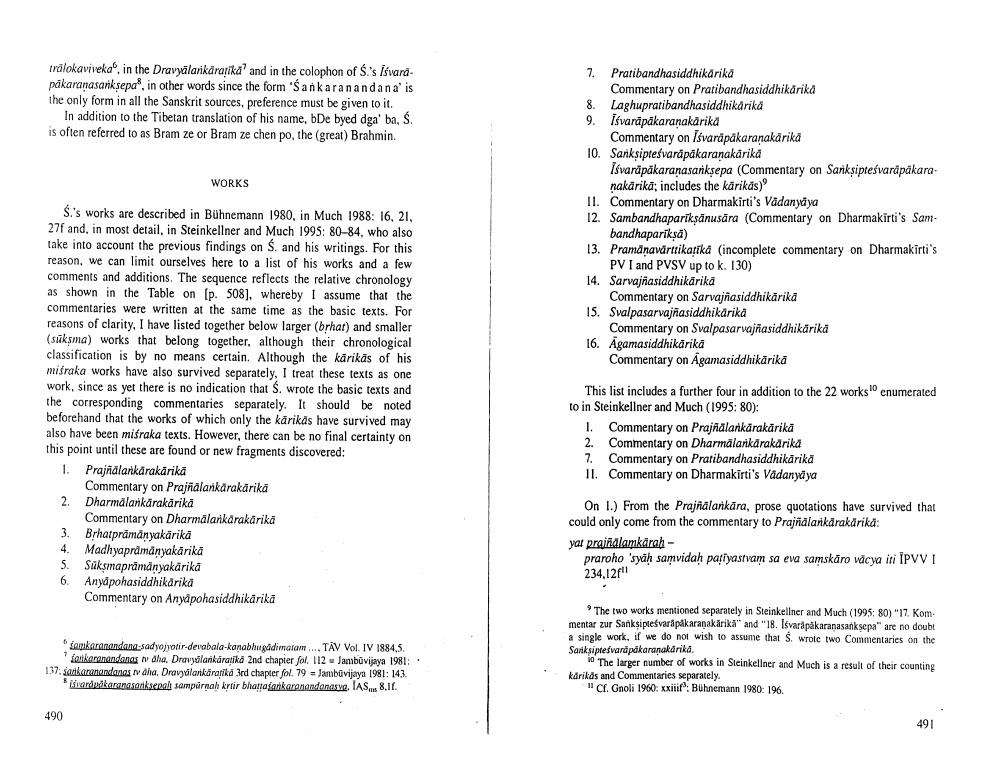Book Title: On Dates And Works Of Sankaranandana Author(s): Helmut Krasser Publisher: Helmut Krasser View full book textPage 2
________________ tralokaviveka, in the Dravyalarikaratika' and in the colophon of Ś's išvardpakaranasanksepa", in other words since the form 'Sankaranandana' is the only form in all the Sanskrit sources, preference must be given to it. In addition to the Tibetan translation of his name, bDe byed dga' ba, S. is often referred to as Bram ze or Bram ze chen po, the (great) Brahmin. WORKS 7. Pratibandhasiddhikarika Commentary on Pratibandhasiddhikarika 8. Laghupratibandhasiddhikarika 9. Isvarapakaranakarika Commentary on Isvarapakaranakarika 10. Sanksipteśvarapakaranakarika Isvarapakaranasanksepa (Commentary on Sanksipreśvarapakara nakarika: includes the karikas) II. Commentary on Dharmakirti's Vadanyaya 12. Sambandhapariksanusāra (Commentary on Dharmakirti's Sam bandhapariksa) 13. Pramdnavdrttikatika (incomplete commentary on Dharmakirti's PV I and PVSV up to k. 130) 14. Sarvajñasiddhikarika Commentary on Sarvajñasiddhikarika 15. Svalpasarvajñasiddhikarika Commentary on Svalpasarvajñasiddhikarika 16. Agamasiddhikarikā Commentary on Agamasiddhikärika Si's works are described in Bühnemann 1980, in Much 1988: 16, 21, 27f and, in most detail, in Steinkellner and Much 1995: 80-84, who also take into account the previous findings on S. and his writings. For this reason, we can limit ourselves here to a list of his works and a few comments and additions. The sequence reflects the relative chronology as shown in the Table on (p. 508), whereby I assume that the commentaries were written at the same time as the basic texts. For reasons of clarity. I have listed together below larger (brhar) and smaller (sūksma) works that belong together, although their chronological classification is by no means certain. Although the kärikäs of his misraka works have also survived separately, I treat these texts as one work, since as yet there is no indication that S. wrote the basic texts and the corresponding commentaries separately. It should be noted beforehand that the works of which only the kärikas have survived may also have been misraka texts. However, there can be no final certainty on this point until these are found or new fragments discovered: 1. Prajñalankärakarika Commentary on Prajñalankarakarika 2. Dharmalankarakarika Commentary on Dharmálankarakarika 3. Brhatprāmänyakärikä 4. Madhyapramanyakärika 5. Saksmaprāmányakärikā 6. Anyāpohasiddhikarika Commentary on Anydpohasiddhikarika This list includes a further four in addition to the 22 works enumerated to in Steinkellner and Much (1995: 80): I. Commentary on Prajñalarkarakārika 2. Commentary on Dharmalankarakarika 7. Commentary on Pratibandhasiddhikarika II. Commentary on Dharmakirti's Vadaryd ya On 1.) From the Prajñalankāra, prose quotations have survived that could only come from the commentary to Prajndlankarakärika: yat praindlamkarah praroho 'syah samvidah pafiyastvam sa eva samskaro wacya iti IPVVI 234,121" sukaranandang-sadyojyotir devabala-kanabhuigdimalam ....TĀV Vol. IV 1884.5 ankaranandanes in the Dravydlankaratika 2nd chapter fol. 112 - Jambüvijaya 1981: 137. jankaranandanas tv dha Dravydlankaratika Ied chapter fol. 79 = Jambūvijaya 1981: 143 Hardikaranasan sa sampurnah krtir bhaagankaranandanasve, IAS. 8.11. The two works mentioned separately in Steinkellner and Much (1995: 80) 17. Kom mentar zur Sanksiptesvarapakaranakärikā" and "18. Isvarapakaranasanksepa" are no doubt a single work, if we do not wish to assume that s wrote two Commentaries on the Sanksipevandpakaranakarika. 10 The larger number of works in Steinkellner and Much is a result of their counting karikas and Commentaries separately. * Cr. Gnoli 1960: xxiiif: Bühnemann 1980: 196 490 491Page Navigation
1 2 3 4 5 6 7 8 9 10 11
